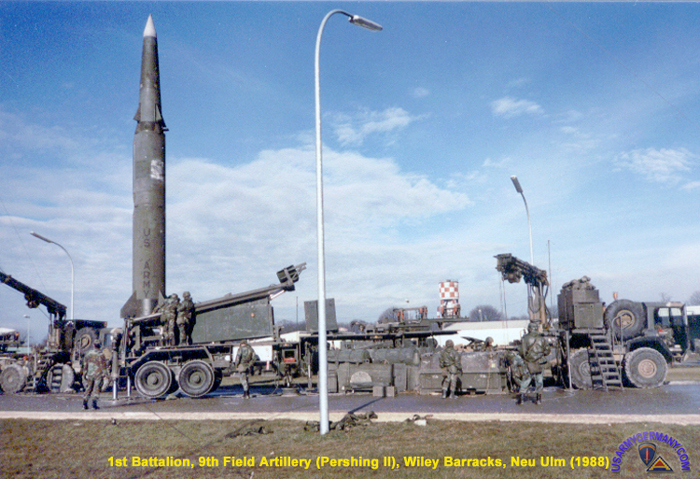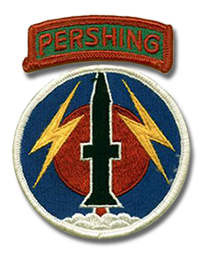If you do
NOT see the Table of Contents frame to the left of this page, then
Click here to open 'USArmyGermany'
frameset |
56th Field Artillery Brigade
PAGE 2 - Missiles and Doctrin: P1, P1A and P2
Looking for more information from military/civilian
personnel assigned to or associated with the U.S. Army
in Germany from 1945 to 1989. If you have any
stories or thoughts on the subject, please contact me . .
|
|
|
|
|
|
| Pershing
1/1-A Weapon System |
|
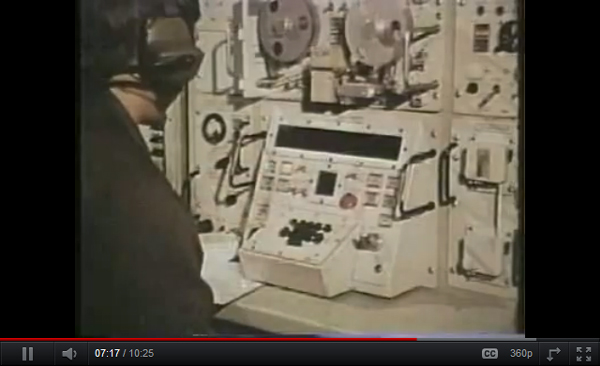
Big Picture Series: Pershing 1A (Movie - 10+ min) (Source: YouTube) |
|
| (Source: Martin
Marietta Pamphlet July 1971) |
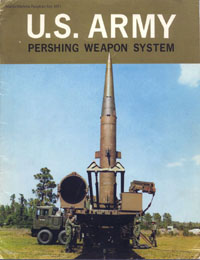 |
|
The
PERSHING weapon system was
first deployed in 1964 to Europe.
At hidden firing sites deep in the German forest, elite
PERSHING crewmen are armed with nuclear-tipped, two-stage,
solid propellant missiles. Ready for launch from tracked
vehicles, the missiles are counted down, and checked out
by a mobile programmer-test station (far left in photo
#1). A radio terminal set with an inflatable antenna (far
right, photo #1) maintains contact with higher headquarters.
PERSHING's mobility, and firepower led to its choice for
the vital Quick
Reaction Alert (QRA) mission in support
of NATO.
To increase PERSHING's ability to shoot, move, and communicate
in its QRA role, in January 1966 the Army awarded a contract
for new ground equipment designated PERSHING
1-A.
EMPLOYMENT: Pershing is capable of providing Quick
Reaction Alert (QRA) fire support for the theater and
General Support for the Field Armies. The battalion -
composed of four firing batteries, a headquarters battery,
and a service battery - can attack any target within range
in any direction. By maneuvering the firing batteries,
commanders possess a powerful means of influencing the
course of combat and can deliver nuclear fire over a zone
of great width and depth, shifting and concentrating fire
according to the situation.
Currently, Pershing 1 is deployed with U.S. and Federal
Republic of Germany units in Europe. When available, Pershing
1-A will further strengthen the deterrent capability of
NATO forces by reducing reaction time and increasing reliability
of the Pershing system. |
|
|
| |
| PERSHING 1 |
Prime
mover for the Pershing 1 (P1) system is the M-474 tracked vehicle,
using major components of the M-113 light armored personnel carrier.
Four of the tracked vehicles are used to transport the system. The
M-474 has a 200 mile cruising range, and a maximum forward speed over
the road of about 40 miles per hour. It can ford a stream 42 inches
deep. It is about 18 feet long, 8 feet wide, and weighs about 12,000
pounds gross.
The P1 missile less the warhead section is carried on a mobile erector-launcher
mounted on a M-474. The erector-launcher can be removed from the tracked
vehicle for transport by air. The P1 erector-launcher, developed by
Thompson-Ramo-Woolridge, weighs about 5,800 pounds, is about 20 feet
long, 7 feet wide and 9 feet high overall. The other three major units
also transported on M-474's are the warhead section, the programmer-test
station (PTS)/power station (PS) and the tropospheric-scatter radio
terminal set. Collins Radio Company produces the communication equipment.
Pershing 1 was retired from active duty with the US Army in September
1970 and is currently being phased out of the FRG Air Force "gruppes."
This transition to P1-A will be completed by late 1971. |
|

1. Pershing
1 firing battery (KB)
|

2. Current
PERSHING 1 Firing Site - Somewhere in Germany (KB)
|
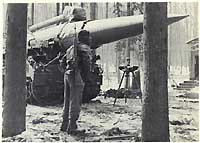
3. Sentry
guards nuclear warhead (KB) |
|
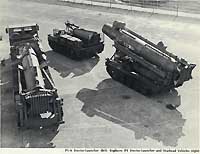
4. P1-A
Erector-Launcher replaces P1 vehicles (KB)
|
|
|
|
|
|
| |
| PERSHING
1-A |
In order to increase the system's ability to shoot, move and communicate
in its QRA role, the US Army in January 1966 awarded a contract to
Martin Marietta Corporation for development of new ground equipment
designated Pershing 1-A. The first 1-A production contract was awarded
Martin Marietta in November 1967.
Faster erector-launchers and the introduction of solid state electronics
contribute to a more rapid rate of fire and even greater reliability.
The biggest outward change -- but not the only one -- is a shift from
tracked vehicles to wheels for all ground support equipment, including
the improved erector-launcher.
The switch to this new equipment was accomplished through a unique
logistics plan known as "SWAP." Battalion-size "packages"
of P1-A equipment were formed at Cape Kennedy, Florida, then shipped
intact to Pershing units in the field. New equipment was then substituted
for the old without affecting the readiness posture of the unit. The
first such "swap" effort took place early in August 1969.
Under the P1-A program, there is no change to the basic 35 foot inertial-guided
missile. Each battery has several missiles, each on its own erector-launcher.
The wheeled ground equipment features an erector-launcher which carries
the complete missile on a transporter or semi-trailer towed by a M-757
tractor. The M-757 is a modification of the basic M-656 truck developed
for the Army by Ford Motor Company. |
|
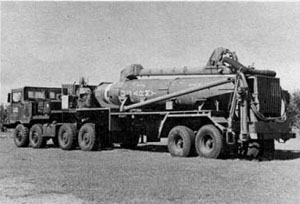 |
|
Erector-Launcher
The P1-A erector-launcher (EL) is designed for rapid movement
from one firing position to the next and is capable of
fast erection and firing. It can also be transported in
C-130 aircraft.
Hydraulic lifts in the improved EL raise the missile from
the horizontal traveling cradle to the vertical firing
position in a matter of seconds.
|
|
| |
|
|
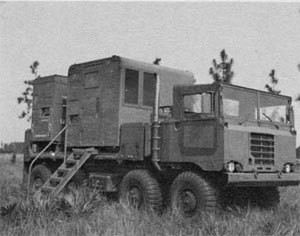 |
|
Programmer-Test
Station
The improved programmer-test station (PTS), mounted on
an M-656 vehicle, provides the means for rapid missile
checkout and countdown. It is equipped with computer control
devices and performs automatic self-test and malfunction
isolation. Modern electronic packaging, featuring plug-in
mircomodules, allows the operator to perform repairs at
the firing site.
Mounted on the same vehicle is the power station, which
provides energy for the entire system.
|
|
| |
|
|
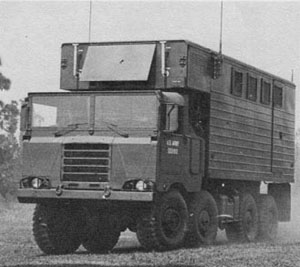 |
|
Battery
Control Central
A new but integral part of the P1-A firing unit is a battery
control central (BCC) to facilitate the performance of
command functions in the QRA role. The BCC consists of
an expandable shelter containing communications equipment
and a power unit mounted on an M-656 vehicle. Through
the facilities of the BCC, the battery commander will
be able to maintain more intimate control over the firing
positions at the battery firing sites. When a missile
is ready for launch, the fire button can be pushed from
the BCC or, at the commander's option, the fire box can
be removed and operated from a remote location.
|
|
| |
|
|
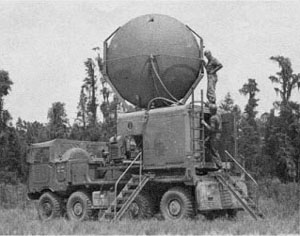 |
|
Radio
Terminal Set
Another M-656 carries the radio terminal set (RTS) which
provides voice and teletype networks for the battery.
The van is topped by an inflatable parabolic antenna which
can be stored in a recessed space during road travel.
New to the operation is a single side-band voice system
for increased command communications.
|
|
|
 |
|
|
| Pershing
2 Weapon System |
|
|
|
|
|
|
 |
|
|
| Related Links: |
| |
|
